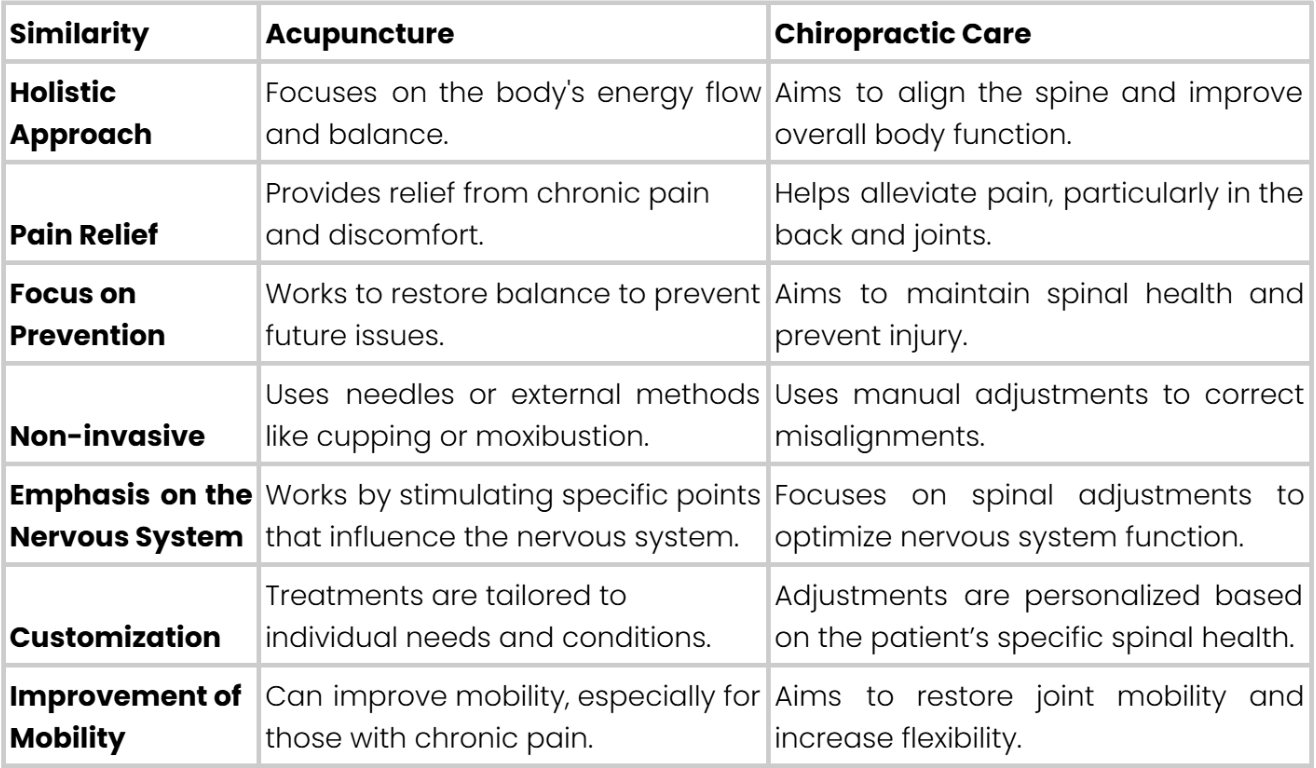Let’s start by saying it is natural for anyone to feel pain. Unfortunately, what often adds to the physical discomfort is the frustration of trying to find the best treatment that suits us best. While some people are willing to consult with a doctor, others prefer the convenience of seeking answers online.
If you belong to the latter group and are wondering whether acupuncture or chiropractic care is the right choice for you, read on to explore the key differences, benefits, and considerations of these two approaches.
What Is Acupuncture?
Acupuncture is a traditional Chinese medicine practice that involves inserting thin needles into specific points on the body. These points are believed to stimulate energy flow and promote the body’s natural healing processes. Acupuncture is commonly used to treat pain, stress, and various health conditions.
What Is Chiropractic Care?
Chiropractic care focuses on the diagnosis and treatment of musculoskeletal disorders, particularly those related to the spine. Chiropractors use hands-on spinal manipulation and other manual techniques to improve alignment, relieve pain, and enhance overall function.
Key Differences Between Acupuncture and Chiropractic Care
While both chiropractic and acupuncture are known as effective solutions for pain management, there are many differences regarding the treatment approach, the conditions treated, and safety and effectiveness.
Below, we will give you insight into the main differences between acupuncture and chiropractic.
Treatment approaches
Chiropractic uses a hands-on approach to examine, diagnose, and treat patients. One of the most common forms of chiropractic treatment is spinal manipulation to restore the mobility of the joints. These treatments are ideal for patients experiencing back, neck, and joint pain. After a treatment session, some patients have felt soreness or pain in some body areas. However, many of these ailments dissipate after 24 hours.
Acupuncture, on the other hand, focuses on stimulating specific points in the body, usually by inserting thin needles into the skin and then manipulating them by hand or using electrical stimuli. Acupuncture can be more suitable for people whose bodies are unable to take the often-strong pressure and for those who seek an effective technique for relaxation or detoxification of the body.
In a few words, while acupuncture emphasizes energy systems, chiropractic care targets the physical framework of the body.
Techniques used
Although acupuncture and chiropractic care are two alternative therapies that aim to improve overall health and wellness, they use distinct techniques to highlight the core differences in how acupuncture and chiropractic care address pain and promote overall wellness.

Target areas

Acupuncture treats various conditions, from carpal tunnel syndrome to fibromyalgia and tennis elbow. It can also boost the immune system, improve respiratory health, relieve insomnia, and reduce stress while providing emotional balance. Additionally, acupuncture can help those recovering from illnesses, injuries, or surgery heal faster.
On the other hand, chiropractic treatments are primarily recognized as a possible option for patients experiencing neck, back, or joint pain, headaches, and neuromusculoskeletal problems. The most significant advantage of chiropractic treatments is that they are non-invasive, drug-free, and incredibly effective in treating various conditions.
More specifically, acupuncture might help treat a patient’s widespread fibromyalgia symptoms by addressing multiple energy pathways, while chiropractic care might concentrate on relieving specific joint dysfunctions contributing to the pain.
Effectiveness and safety
Acupuncture and chiropractic care are both widely regarded as safe when administered by licensed professionals, though their effectiveness can vary depending on the condition being treated and the individual’s response.
Acupuncture is particularly effective in managing chronic pain, stress-related ailments, and tension headaches. According to a study that included acupuncture patients, 79.5% reported improved mood, while 90.9% experienced enhanced mobility. Furthermore, 93.2% of participants stated they would recommend acupuncture based on their outcomes.
Although relatively few complications from acupuncture have been reported, issues can arise if nonsterile needles are used or treatments are improperly administered. Serious adverse effects, such as infections, punctured organs, and injuries to the central nervous system, underscore the importance of proper delivery.
Chiropractic care, on the other hand, is especially effective for treating acute injuries, spinal misalignments, and joint-related issues. In another study, including 155 patients, 81% expressed satisfaction with their chiropractic treatment, highlighting its success in addressing these specific health concerns.
Timeframe for results
Acupuncture often requires a series of sessions to achieve noticeable improvements, particularly for chronic conditions. The treatment works progressively by stimulating specific points to restore balance within the body. For example, individuals with chronic pain or stress-related ailments may need weekly sessions over several months to experience significant relief and sustained benefits.
Chiropractic care, by contrast, can sometimes provide immediate relief for acute issues, such as a sudden spinal misalignment or joint discomfort. However, addressing chronic conditions like persistent back pain or posture-related problems requires a longer-term treatment plan, with adjustments scheduled weekly or biweekly over several months to maintain alignment and support healing.
Similarities Between the Two
Although acupuncture and chiropractic care target different conditions and illnesses, they share several similarities. Both therapies are alternative and holistic approaches to health that emphasize the body’s ability to heal itself. They focus on treating the root cause of discomfort rather than just alleviating symptoms.
Here are some of the most notable similarities between the two therapies:

Limitations of Each Approach
Acupuncture, while highly effective for many chronic conditions, has its limitations. One key limitation is its reduced effectiveness for acute injuries, such as sprains or fractures. While acupuncture can help manage pain and promote healing over time, it may not provide immediate relief for sudden injuries, making it less ideal as a first-line treatment in these situations.
Additionally, acupuncture often requires a series of treatments to achieve noticeable results. This means it may take several sessions, sometimes over weeks or months, for significant improvement, which can be time-consuming for individuals seeking quicker results.
For those with a fear of needles or heightened sensitivity, acupuncture can also be uncomfortable, limiting its appeal. Finally, acupuncture is not suitable for all conditions. It is not recommended for active infections or certain medical emergencies that require conventional medical interventions, which can be a limitation for people with specific health concerns.
Chiropractic care also has its own set of limitations. While it’s effective for musculoskeletal issues like spinal misalignments and joint pain, it may not be ideal for individuals with certain health conditions, such as severe osteoporosis, spinal instability, or neurological issues. In these cases, chiropractic adjustments could pose a risk, and alternative treatments may be more appropriate.
Though many people find relief from chiropractic care, spinal adjustments can sometimes cause temporary discomfort or soreness, and in rare cases, more serious complications like herniated discs or nerve damage can occur.
Additionally, chiropractic care often requires ongoing maintenance for chronic conditions, with frequent visits necessary to maintain spinal alignment. Similar to acupuncture, this can be costly and time-consuming for those seeking long-term relief.
How to Choose Between Acupuncture and Chiropractic Care

The nature of your primary concern is a key factor in determining which therapy might be best. Acupuncture, as mentioned throughout the article, excels in addressing chronic or systemic issues like tension headaches, anxiety, or digestive problems by working progressively to restore balance within the body. On the other hand, chiropractic care is particularly effective for acute injuries, spinal misalignments, or joint pain.
It’s also important to consider your comfort level with the techniques involved. Acupuncture involves fine needles, cupping, or gentle heat applications such as moxibustion. For those open to these minimally invasive methods, acupuncture can feel soothing and therapeutic. Conversely, if a more hands-on approach resonates with you, chiropractic care may feel more familiar and reassuring.
Both modalities require some commitment, so it’s worth considering how they fit into your lifestyle. Acupuncture usually involves weekly or biweekly appointments, particularly for long-standing conditions. Chiropractic care may also necessitate ongoing visits for chronic concerns, but some individuals find relief in fewer sessions, especially for acute injuries. Reflecting on your availability and willingness to invest time in your healing journey can help clarify your decision.
While self-evaluation and taking the time to reflect on your condition, symptoms, and personal preferences provide valuable clarity, it is really helpful to consult with licensed professionals and reach out to acupuncture and chiropractic practitioners for their input.
Many acupuncturists and chiropractors offer initial consultations where they can assess your condition and explain whether their approach is suitable for your needs. Consulting both sides allows you to gather different perspectives, giving you a broader understanding of what each therapy can offer.
The Bottom Line
One thing to remember is that both acupuncture and chiropractic are alternative healthcare sources employed to help with pain relief. While chiropractic is suggested if you have neuromusculoskeletal issues, acupuncture is mainly preferred for managing pain.
When it comes to chiropractic vs. acupuncture, choosing between the two really comes down to which you are most comfortable with or which your physician recommends. Those who lean towards acupuncture and want to learn more about the procedure, contact us for more information. And if you wish to experience the benefits of acupuncture first-hand, book an appointment today!
Frequently Asked Questions
Can you combine both therapies?
Yes, it is possible to combine acupuncture and chiropractic care, and in many cases, doing so can enhance the overall benefits. However, it’s important to consult with your healthcare providers before starting both therapies to ensure they complement each other and are appropriate for your specific condition.
Who should avoid acupuncture or chiropractic care?
Acupuncture should be avoided by those with a fear of needles, certain skin conditions, blood clotting disorders, or during early pregnancy.
Chiropractic care may not be suitable for people with severe osteoporosis, fractures, or spinal instability.
Are there any risks or side effects with acupuncture and chiropractic care?
Acupuncture-related side effects may include mild soreness or bruising, though serious risks like infections are rare with proper technique.
During chiropractic care, soreness or stiffness can occur post-treatment; in rare cases, more serious complications like nerve damage may happen.